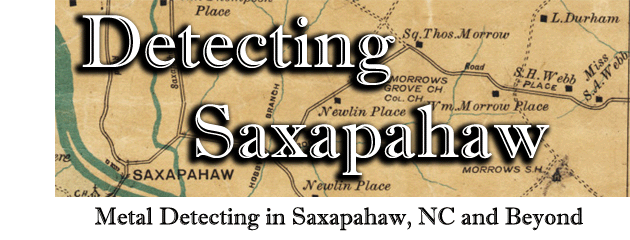I’m quite pleased with my own recoveries over the course of
the weekend. I will begin with this blog
post discussing my lead finds, and move on to brass, pewter, and iron in a
follow-up post. Detecting near the road
I found a nice variety of different bullet types. The most iconic and widespread bullet of the
war is the three-ring minie ball.
Despite their prevalence, I only found one of these the entire
weekend! I didn't photograph it for this post, but you can see numerous examples previously on the blog.
I dug two kinds of cavalry bullet, Sharps carbine and
Spencer carbine. The Sharps carbine
breech-loader rifle would have originally used a paper or linen gunpowder
cartridge attached to the bullet, but this has long ago deteriorated. The Spencer repeating rifle loaded seven
cartridges at a time through the buttstock of the weapon. These cartridges were composed of a lead
bullet and brass casing, although it is uncommon to recover them intact. Shown here is a Spencer bullet with a small
part of the brass casing remaining, fresh from the dirt. I liked the look of it so much that I intent
to preserve it in the original dirt as shown for future display.
Round lead bullets were in use long before the Civil War in smooth bore muskets and pistols. Although they were eclipsed in accuracy and range by the conical Minie-ball
style bullet, roundballs still saw extensive use during the war. I found quite a few roundballs on this
particular trip, from 44 to 69 caliber.
I recovered four gardner bullets which I’m particularly happy with,
as I don’t tend to find many of them here in North Carolina. These Confederate made bullets held the
paper cartridge in a groove in the base of the bullet, which can be seen here.
Most of the bullets I found at DIV would be called "drops" or "dropped bullets", meaning that they have never been fired. But I also dug these two fired bullets. The bullet on the left obviously hit something quite hard, and is mushroomed out beyond recognition. The bullet on the right is an Enfield bullet. Note the ramrod mark on the nose of the bullet from where it was pushed hard into the barrel of the gun, along with the lines along the length of the bullet from where the bullet caught the rifling grooves inside the barrel as it was fired.
Most of the bullets I found at DIV would be called "drops" or "dropped bullets", meaning that they have never been fired. But I also dug these two fired bullets. The bullet on the left obviously hit something quite hard, and is mushroomed out beyond recognition. The bullet on the right is an Enfield bullet. Note the ramrod mark on the nose of the bullet from where it was pushed hard into the barrel of the gun, along with the lines along the length of the bullet from where the bullet caught the rifling grooves inside the barrel as it was fired.
My favorite lead find was this highly carved Bartholow
pattern pistol bullet. The bullet was originally meant to
be fired by a Colt Army revolver or similar 44 caliber pistol. In addition to the obvious alteration around
the nose of the bullet, there is also carving on the lower ring including a
series of vertical lines shown here. We may never know why a soldier took the time
to create this intricately carved bullet, but many were carved as chess pieces,
works of art, or simply to relieve the boredom of camp life.
That’s it for now. Stay tuned for the next installment – my brass and pewter finds from DIV XXIII. Thanks for reading!
That’s it for now. Stay tuned for the next installment – my brass and pewter finds from DIV XXIII. Thanks for reading!


